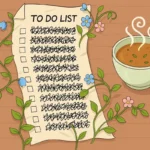For Frazzled Parents: How to Find Your Calm in the Midst of Chaos
Featuring Insights from Kari Kampakis, Author of More Than a Mom
I. The Morning Before the Storm
It was 7:42 a.m., and the morning was hanging by a thread. The kids were half-dressed. The cereal box had just exploded across the kitchen floor. And that’s when the text came in—from her. Your co-worker. The one who sends urgent “need-this-now” messages before coffee has even cooled, whose chaos somehow seeps into your day before it’s even begun.
You were still in the relative calm of your ordinary morning—scrambling eggs, tying shoes, balancing toast on a plate while reminding one child to brush their teeth and another to please stop feeding the dog grapes—when her all-caps WE HAVE A CRISIS pulled you into battle. Suddenly, you weren’t just managing sibling squabbles. You were fending off a workplace firestorm from your phone.
II. Why Your Calm Is Their Anchor
By 8:03, you’d snapped at the kids to hurry. You’d spilled coffee on your shirt. You’d fired off a rushed reply that didn’t sound like you but sounded exactly like someone who hadn’t taken a full breath in twenty minutes. The house was loud, but your pulse was louder. And the day hadn’t even begun.
Kari Kampakis, in her book More Than a Mom, offers this reminder: your calm is the anchor your family needs. When you nurture your own joy and emotional balance, you don’t just improve your mood—you give your children a living example of how to navigate life without being consumed by it.
Calm isn’t about pretending the chaos doesn’t exist. It’s about pausing, resetting, and teaching—by your actions—that big emotions and big problems can be handled without self-destructing.
III. The Hidden Weights You Carry
Parents carry a quiet, relentless load.
- The unspoken expectations—your own and everyone else’s—stack up until they feel impossible.
- Work deadlines and family demands clash like cymbals in your brain.
- Children’s meltdowns, sibling stand-offs, endless forms to sign, lunches to pack, reminders to repeat.
- No time for real rest.
- That gnawing guilt that you’re not doing enough, even though you’re doing more than you ever thought you could.
Kampakis urges parents to drop the myth of perfection. No one is keeping score on spotless houses or perfectly curated schedules. Real peace comes when you trade impossible standards for realistic rhythms, swap constant firefighting for small pockets of renewal, and accept that storms are a natural part of family life.
IV. The Oxygen Mask Moment
By 8:12, your co-worker had sent three follow-up texts with the kind of dramatic urgency usually reserved for actual building fires. The kids were arguing about who got the last clean spoon. The dog was barking at the mail truck. Your head felt like it might float away.
And then—like someone tapping your shoulder—you remembered: if you didn’t put on your own oxygen mask first, you’d be useless to everyone. So you set the phone down. You stepped outside. One breath. One small ritual. One compassionate choice.
The air was cool. The sun was warm on your face. The quiet stretched out for just long enough for your shoulders to drop. You didn’t fix the world. But you fixed your body’s response to it. And that was enough to re-enter the storm differently.
V. Tools for the Quest
Kampakis’s work offers more than philosophy—it offers tools. Ways to build and protect the calm that allows you to show up for your children, your work, and yourself without falling apart.
- Pause and Connect with Yourself: Even five minutes alone can feel like a reset button. Step outside. Sit in a parked car. Close your eyes. Notice something beautiful—a bird’s song, a patch of blue sky—and let that moment become a tether back to yourself.
- Build Gentle Routines: Routines aren’t about rigid schedules—they’re about creating small, reliable rituals that make life feel less like a runaway train. Slow breakfasts. Evening walks. Sunday pancakes. “Happy Mondays” with an easy dinner and a favorite show. These small patterns tell everyone, this is our rhythm.
- Label Your Feelings: Say it: “I’m overwhelmed.” “I’m anxious about tomorrow.” “I’m tired and need rest.” Naming what you feel takes it out of the shadows and puts it in front of you, where you can meet it with compassion instead of judgment.
- Celebrate Small Wins: Caught yourself staying patient during a meltdown? Noticed your child quietly working through a problem without exploding? Stop and savor it. These are signs your work is paying off—little glimmers that keep you going.
- Ask for Help and Accept Support: This is not a solo mission. Call a friend. Swap school pickup duties. Text a neighbor when you’re running late. There is no award for suffering alone.
VI. Bonus Armor: Tapping for Stress Relief
Pair Kampakis’s message with a simple Emotional Freedom Technique (EFT) routine to help your nervous system reset when the day spikes your stress.
Setup Statement:
“Even though parenting is overwhelming right now, I completely accept myself.”
Sequence:
- Eyebrow: “This chaos feels so heavy.”
- Side of Eye: “I’m frazzled and stressed.”
- Under Eye: “Trying to do too much.”
- Under Nose: “I want to find my calm.”
- Chin: “Breathing, letting tension go.”
- Collarbone: “Releasing today’s stress.”
- Under Arm: “I am safe and present.”
- Top of Head: “I am calm in the midst of chaos.”
Repeat until you feel a shift. Remember—your children benefit from the calmer version of you far more than from the hurried, burned-out version who’s just trying to push through.
VII. Passing the Elixir
Your children watch you more than they listen to you. When you take time to regulate yourself, you’re quietly teaching them how to handle their own storms.
- Name feelings together: “It’s okay to be frustrated—let’s take deep breaths.”
- Model taking breaks: “I need a quiet minute.”
- Use humor to dissolve tension: turn a sibling squabble into a goofy face contest.
They see that calm isn’t about the noise disappearing—it’s about creating steady ground inside yourself no matter what’s happening outside.
VIII. The Return Home
By 8:24, you stepped back into the kitchen. Your co-worker’s problem was still sitting in your inbox, but now it was just a problem—not an all-consuming emergency. The kids noticed something different in you. They were still buzzing with energy, but the shouting had faded. Someone was laughing. The air felt lighter.
You answered the work email with a clear head. You handled the breakfast mess without snapping. The coffee stain was still there, the spoon still missing, but the morning had shifted. Because calm doesn’t erase the chaos—it makes you the anchor in it.
IX. Why This Matters More Than You Think
Every time you choose to breathe before reacting, you’re teaching your children something profound. You’re showing them that life doesn’t have to be lived at the mercy of every loud moment, every angry email, every spilled cup of milk. You’re showing them that emotions are waves—they rise, they crest, they fall—and you can ride them without drowning.
And in doing so, you’re building something far bigger than a peaceful morning. You’re building resilience. You’re teaching compassion. You’re giving them a living blueprint for how to move through the world without losing themselves.
X. Closing Beat
Moments of mindful mothering.
Breathing breaks bring balance.
One breath. One small ritual. One compassionate choice.
Kampakis writes, “Don’t forget to take care of yourself.” It’s not indulgence—it’s essential maintenance for the life you’re holding together. So today, when the text comes from your co-worker, or the kids spill cereal, or the dog barks at the mail truck, remember: the chaos will come. But so can the calm. And the calm will come from you.



